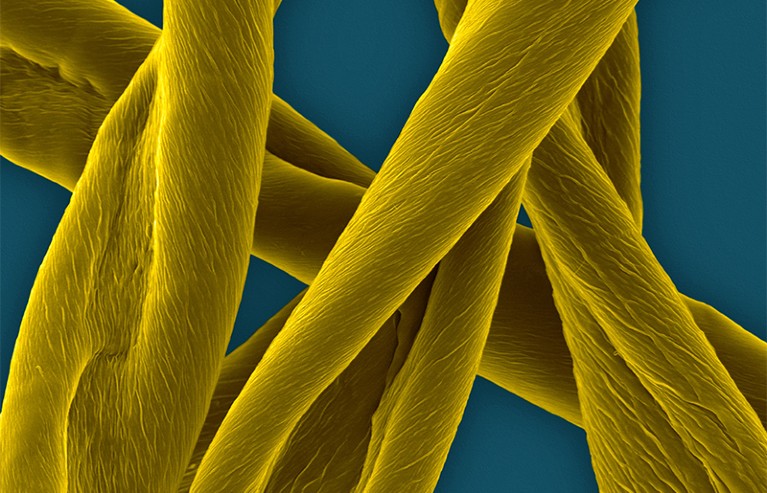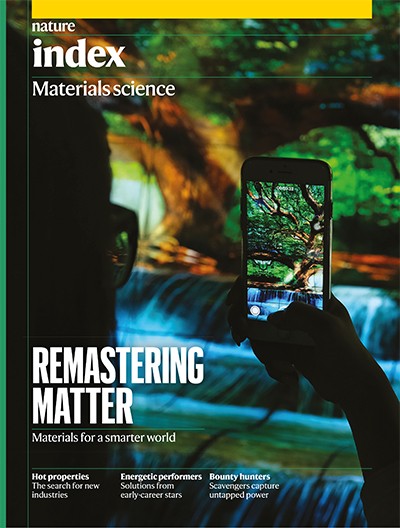
Cotton fibres can become conduits for ions, atoms, or molecules, and generate electricity.Credit: Dennis Kunkel Microscopy/Science Photo Library
Wood seems an unlikely material for the forefront of an energy revolution. But materials scientist Tian Li believes it could unlock electricity from a source of energy that is both sustainable and ubiquitous: our own body heat.
The key lies in the remarkable fibrous structure of cellulose, the main component of wood, paper and cotton. These nanoscale fibres are “a beautiful structure” and a marvel of natural molecular engineering, says Li, a postdoctoral researcher at the University of Maryland. When treated with a chemical bath, the fibres can become conduits for ions, atoms or molecules with a net electrical charge. By exploiting how ions move in the presence of heat, they can generate electricity, even from small temperature differences, recovering energy that would otherwise be lost to the atmosphere.
Nature Index: Materials science
This is just one way that researchers and companies are trying to scavenge energy from our ambient environment in its many forms, including radio waves, vibrations and sound. The global ‘energy harvesting’ industry is worth around US$500 million, and growing by roughly 10% each year, according to industry reports. Its development is seen as crucial to the expansion of the Internet of Things (IoT), a vision in which our homes, offices and infrastructure are made ‘smart’ with vast numbers of networked sensors. Proponents also say it can contribute to a greener world. “We need as many technologies as possible to generate sustainable energy,” says Li.
Wooden heat
Li and her colleagues at the University of Maryland developed a process for soaking slabs of common American basswood in a chemical bath of sodium hydroxide (T. Li et al. Nature Mater. 18, 608–613; 2019). This extracts the lignin, a natural polymer intertwined around the cellulose fibres, which gives wood its brownish hue. The treatment also breaks the hydrogen bonds along the remaining cellulose nanofibres and forms a crystalline structure with highly aligned molecular strands, along which sodium and hydroxide ions can freely travel.
Li fabricated similar materials when she studied semiconductors in graduate school, but this process is much simpler. “I recall having to go to the fabrication lab for a week to make sure all the channels were aligned and perfect,” she recalls. “Then, when I did my postdoc, I was looking at this material [wood] and was amazed. It had perfectly aligned channels.”
When placed against a heat source, the nanostructure of the cellulose allows the sodium ions to drift away from the source more easily than the hydrogen ions, creating an electric potential that can later be tapped to release electricity. This treated cellulose can harvest heat energy from sources just 5 °C warmer than its surroundings.
Li envisions shirts made of similarly treated cotton, which is nearly pure cellulose, that could harvest body heat, storing it in a battery to recharge phones, or charging them wirelessly in pockets. “Previously, when people talked about wearable flexible devices, they put this device on top of a substrate,” she says. But in this case, a separate surface is not needed. “Your cotton t-shirt can be a device itself.”
Wood could also potentially tap into other industrial sources. It is estimated that the global amount of low-grade wasted heat from industrial processes and other sources is enough to power more than 6,000 typical one-gigawatt nuclear reactors.
Sensing an opportunity
Over the past decade, the potential of energy harvesting has been alternately hyped and challenged. Some applications have been stymied by physics: absorbing a sufficient amount of energy requires devices that are too large to fit in small sensors that can use cheaper batteries instead.
“The key is coupling the energy harvester to a low-power processor or radio,” says Mike Demler, a semiconductor technology analyst with the Linley Group, a Californian consulting firm.
Many people view the sensors in IoT devices as a key application for energy harvesting. “Sensors usually consume very little power,” says Kim Dong In, an electrical engineer at Sungkyunkwan University in Suwon, South Korea. The problem with IoT sensors, he says, is the vast number of them that need to be deployed, and the challenge of recharging them or replacing their batteries. Energy harvesting is a natural fit for powering sensors that are not easily accessible — behind the walls of a smart home, for instance, or embedded in the structure of a bridge to monitor its integrity. Kim sees these as perfect environments for devices that can recharge themselves by harvesting energy from radio waves. “We cannot see them, but a lot of energy is available from surrounding electromagnetic signals such as TV, wifi and cellular phone towers,” he says.

An illuminated installation that takes its energy from the footsteps of people passing by.Credit: Eden Breitz/Alamy
In such rechargeable devices, an antenna picks up radio waves, which induce an alternating current. This is passed along to a diode, which converts the signal into a direct current that can charge a capacitor. The challenge is that the effective charging range is only a few metres and diodes are not very efficient. For example, the signal strength needed to generate useful power far exceeds the signal strength a wifi router needs to maintain a strong connection.
Kim proposes a solution: using a separate base station designed purely to transmit power, not information. In a smart home, this could be incorporated into a robotic vacuum cleaner that roams the house, recharging sensors as it goes. For a bridge, a drone equipped with a power transmitter could fly down its length to top up embedded sensors. This, Kim says, makes radio-frequency harvesting one of the more flexible energy harvesting techniques.
The concept could be taken even further by the use of wallpaper with carefully designed metasurfaces — surfaces with nanoscale structures made of individual units, akin to pixels, that can manipulate the wavefronts of light. By applying a small voltage to each unit, researchers can create an artificial lens, focusing and steering beams of radio waves to their targets.
Some energy harvesting techniques have more proven track records. Wearable devices that harvest energy have been around for centuries: automatic watches, which wind themselves using an oscillating weight as the user moves them, date back to the 1770s. The first electronic device to harvest its own energy in this way was also a watch, patented in 1988 by Seiko. Solar cells have powered watches and calculators for decades, and are frequently used in IoT sensors, says Demler.
Another relatively well-established energy harvesting technique is based on piezoelectrics, materials that generate electric charge when squeezed or pressed. In 1998, MIT researchers were some of the first to experiment with embedding them in shoes — a technique that garnered the interest of the US military. By 2008, Japan was experimenting with embedding piezoelectrics in the floors of subway stations to power turnstiles.
Work continues on a variety of experimental techniques. One promising class of devices works by generating triboelectricity, also known as static electricity. These small devices, called triboelectric nanogenerators, use friction between their moving parts, such as two sheets of flexible polymers or a silicone rubber ball that bounces around a hollow plastic sphere. The first such devices were developed by a team at the Georgia Institute of Technology in Atlanta.
Ultimately, successful implementation of energy harvesting comes down to tailoring a technique for a specific use case, says Demler. Further advances in computer chips that can use lower amounts of power will help, too. As for Li’s nano-engineered wood, she says she’s yet to start work on commercializing it, but plans to once she lands a faculty position. “It’s such an open field,” she says. “And I feel this is truly a field worth exploring.”

 Tomorrow's industries: from OLEDs to nanomaterials
Tomorrow's industries: from OLEDs to nanomaterials
 Five leading early career researchers in materials science
Five leading early career researchers in materials science
 The fastest rising institutions in materials science: visualized
The fastest rising institutions in materials science: visualized



![High carrier mobility along the [111] orientation in Cu2O photoelectrodes](https://media.nature.com/w140h79/springer-static/image/art%3A10.1038%2Fs41586-024-07273-8/MediaObjects/41586_2024_7273_Fig1_HTML.png)

